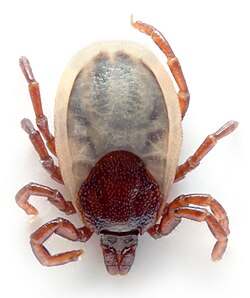- Ventral views of male (left) and female (right) of Diplothyrus lecorrei (Holothyrida, Neothyridae)
- Specimen of Opilioacarus baeticus (Opilioacarida)
- Specimens of Nuttalliella (Ixodida, Nuttalliellidae)
| Parasitiformes Temporal range: | |
|---|---|
 | |
| An Ixodes hexagonus tick | |
 | |
| Varroa destructor (Mesostigmata) | |
| Scientific classification | |
| Domain: | Eukaryota |
| Kingdom: | Animalia |
| Phylum: | Arthropoda |
| Subphylum: | Chelicerata |
| Class: | Arachnida |
| Superorder: | Parasitiformes Leach, 1815 |
| Orders and main families [1] | |
| |
Parasitiformes are a superorder of Arachnids, constituting one of the two major groups of mites, alongside Acariformes. [1] [2] [3] [4] [5] Parasitiformes has, at times, been classified at the rank of order or suborder. [6] [7] [8] [9] [10] [11]
Contents
It is uncertain whether Parasitiformes and Acariformes are closely related, and in many analyses they are recovered more closely related to other arachnids. [3] [12] Amongst the best known members of the group are the ticks, though the Mesostigmata is by far the most diverse group with over 8,000 described species, including economically important species such as the varroa mite.






